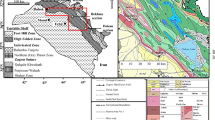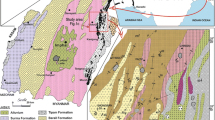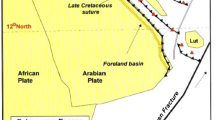Abstract
Stable isotope ratios of 18O/16O and 13C/12C and rare earth elements geochemistry of the Upper Triassic carbonates from the Baluti Formation in Kurdistan Region of Northern Iraq were studied in two areas, Sararu and Sarki. The aim of the study is to quantify the possible diagenetic processes that postdated deposition and the paleoenvironment of the Baluti Formation. The replacement products of the skeletal grains by selective dissolution and neomorphism probably by meteoric water preserved the original marine isotopic signatures possibly due to the closed system. The petrographic study revealed the existence of foraminifers, echinoderms, gastropods, crinoids, nodosaria and ostracods as major framework constituents. The carbonates have micritic matrix with microsparite and sparry calcite filling the pores and voids. The range and average values for twelve carbonate rocks of δ18O and δ13C in Sararu section were –5.3‰ to –3.16‰ (–4.12‰) and –2.94‰ to –0.96‰ (–1.75‰), respectively; while the corresponding values for the Sarki section were –3.69‰ to –0.39‰ (–2.08‰) and –5.34‰ to –2.70‰ (–4.02‰), respectively. The bivariate plot of δ18O and δ13C suggests that most of these carbonates are warm-water skeletons and have meteoric cement. The average ΣREE content and Eu-anomaly of the carbonates of Sararu sections were 44.26 ppm and 1.03, respectively, corresponding to 22.30 ppm and 0.93 for the Sarki section. The normalized patterns for the carbonate rocks exhibit: (1) non-seawater-like REE patterns, (2) positive Gd anomalies (average = 1.112 for Sararu and 1.114 for Sarki), (3) super chondritic Y/Ho ratio is 31.48 for Sararu and 31.73 for Sarki which are less than the value of seawater. The presence of sparry calcite cement, negative 13C and 18O isotope values, the positive Eu anomaly in the REE patterns (particularly for Sararu), eliminated Ce anomaly (Ce/Ce*: 0.916–1.167, average = 0.994 and 0.950–1.010, average = 0.964, respectively), and Er/Nd values propose that these carbonates have undergone meteoric diagenesis. The REE patterns suggest that the terrigenous materials of the Baluti were derived from felsic to intermediate rocks.
Similar content being viewed by others
References
Abedini, A. and Calagari, A.A., 2015, Rare earth element geochemistry of the Upper Permian limestone: the Kanigorgeh mining district, NW Iran. Turkish Journal of Earth Sciences, 24, 365–382.
Ader, M., Macouin, M., Trindade, R.I.F., Hadrien, M.H, Yang, Z., Sun, Z., and Besse, J., 2009, A multilayered water column in the Ediacaran Yangtze platform Insights from carbonate and organic matter paired δ13C. Earth and Planetary Science Letters, 288, 213–227.
Ali, M.Y., 1995, Carbonate cement stratigraphy and timing of diagenesis in a Miocene mixed carbonate-clastic sequence, offshore Sabah, Malaysia: constraints from cathodoluminescence, geochemistry, and isotope studies. Sedimentary Geology, 99, 191–214.
Allan, J.R. and Matthews, R.K., 1977, Carbon and oxygen isotopes as diagenetic and stratigraphic tools: data from surface and subsurface of Barbados, West Indies. Geology, 5, 16–20.
Allan, J.R. and Matthews, R.K., 1982, Isotope signatures associated with early meteoric diagenesis. Sedimentology, 29, 797–817.
Armstrong-Altrin, J.S., Lee, Y.I., Verma, S.P., and Worden, R.H., 2009, Carbon, oxygen, and strontium isotope geochemistry of carbonate rocks of the Upper Miocene Kudankulam Formation, Southern India: implications for paleoenvironment and diagenesis. Chemie der Erde, 69, 45–60.
Armstrong-Altrin, J.S., Madhavaraju, J., Sial, A.N., Kasper-Zubillaga, J.J., Nagarajan, R., Flores-Castro, K., and Rodriguez, J.L., 2011, Petrography and stable isotope geochemistry of the Cretaceous El Abra Limestones (Actopan), Mexico: implication on diagenesis. Journal of the Geological Society of India, 77, 349–359.
Armstrong-Altrin, J.S., Verma, S.P., Madhavaraju, J., Lee, Y.I., and Ramasamy, S., 2003, Geochemistry of Upper Miocene Kudankulam Limestones, southern India. International Geology Review, 45, 16–26.
Armstrong-Altrin, S.J., Ramasamy, S., and Makhnach, A., 2001, Stable isotopes geochemistry and evidences for meteoric diagenesis in Kudankulam Formation, Tamil Nadu. Journal of the Geological Society of India, 57, 39–48.
Avigad, D., Sandler, A., Kolodner, K., Stern, R.J., McWilliams, M., Miller, N., and Beyth, M., 2005, Mass-production of Cambro-Ordovician quartz-rich sandstone as a consequence of chemical weathering of Pan-African terranes: environmental implications. Earth and Planetary Science Letters, 240, 818–26.
Bathurst, R.G., 1972, Carbonate Sediments and Their Diagenesis: Developments in Sedimentology 12 (2nd edition). Elsevier, Amsterdam, 657 p.
Bau, M., 1996, Controls on the fractionation of isovalent trace elements in magmatic and aqueous systems: evidence from Y/Ho, Zr/Hf, and lanthanide tetrad effect. Contributions to Mineralogy and Petrology, 123, 323–333.
Bau, M. and Dulski, P., 1996, Anthropogenic origin of positive gadolinium anomalies in river waters. Earth and Planetary Science Letters, 143, 245–255.
Bellanca, A., Masetti, D., and Neri, R., 1997, Rare earth elements in limestone/marlstone couplets from the Albian–Cenomanian Cismon section (Venetian region, northern Italy): assessing REE sensitivity to environmental changes. Chemical Geology, 141, 141–152.
Bellen, R.C., Dunnington, H.V., Wetzel, R., and Morton, D., 1959, Lexique Stratigraphique Internal Asie, Iraq. International Geological Congress, Fasc. 10a, Paris: International Commission on Stratigraphy (in French), 311 p.
Brand, U. and Veizer, J., 1980, Chemical diagenesis of a multicomponent carbonate system-1: trace element. Journal of Sedimentary Petrology, 50, 1219–1236.
Buday, T., 1980, The Regional Geology of Iraq, Stratigraphy and Paleontology. Dar Al-Kutb Publishing House, Mosul, 335 p.
Budd, D.A. and Land, L.S., 1990, Geochemical imprint of meteoric diagenesis in Holocene ooid sands, Schooner Cays, Bahamas: correlation of calcite cement geochemistry with extant groundwaters. Journal of Sedimentary Petrology, 60, 361–378.
Buonocunto, F.P., Sprovieri, M., Bellanca A., D’Argenio, B., Ferreri, V., Neri, R., and Ferruzza, G., 2002 Cyclostratigraphy and high frequency carbon isotope fluctuations in Upper Cretaceous shallow-water carbonates, southern Italy. Sedimentology, 49, 1321–1337.
Choquette, P.W. and Pray, L.C., 1970, Geologic nomenclature and classification of porosity in sedimentary carbonates. American Association of Petroleum Geologists Bulletin, 54, 207–250.
Condie, K.C., 1991, Another look at rare earth elements in shales. Geochimica et Cosmochimica Acta, 55, 2527–2531.
Coniglio, M., Myrow, P., and White, T., 2000, Stable carbon and oxygen isotope evidence of Cretaceous sea-level fluctuations recorded in septarian concretions from Pueblo, Colorado, USA. Journal of Sedimentary Research, 70, 700–714.
Dai, S., Graham, I.T., and Ward, C.R., 2016, A review of anomalous rare earth elements and yttrium in coal. International Journal of Coal Geology, 159, 82–95.
De Baar, H.J.W., 1991, On cerium anomalies in the Sargasso Sea. Geochimica et Cosmochimica Acta, 55, 2981–2983.
De Baar, H.J.W., Bacon, M.P., and Brewer, P.G., 1985, Rare earth elements in the Pacific and Atlantic oceans. Geochimica et Cosmochimica Acta, 49, 1943–1959.
De Baar, H.J.W., German, C.R., Elderfield, H., and Van Gaans, P., 1988, Rare earth element distributions in anoxic waters of the Cariaco Trench. Geochimica et Cosmochimica Acta, 52, 1203–1219.
Dunham, R.J., 1962, Classification of carbonate rocks according to depositional texture. In: Ham, W.E. (ed.), Classification of Carbonate Rocks. American Association of Petroleum Geologists, Tulsa, p. 108–121.
Elderfield, H., 1988, Tracer in the ocean–the oceanic chemistry of the rare-earth elements. Philosophical Transactions of the Royal Society A, 325, 105–126.
Elderfield, H. and Pagett, R., 1986, Rare earth elements in icthyoliths: variations with redox conditions and depositional environments. Science of the Total Environment, 49, 175–197.
Fairchild, I.J., Marshall, J.D., and Bertrand-Sarfati, J., 1990, Stratigraphic shifts in carbon isotopes from Proterozoic stromatolitic carbonates (Mauritania): influences of primary mineralogy and diagenesis. American Journal of Science, 290, 46–79.
Friedman, I. and O’Neil, J.R., 1977, Compilation of stable isotope fractionation factors of geochemical interest. U.S. Geological Survey, Professional Paper 440K, 12 p.
Gao, G., Dworkin, S.I., Land, L.S., and Elmore, R.D., 1996, Geochemis try of late Ordovician Viola limestone, Oklahoma: implications for marine carbonate mineralogy and isotopic compositions. The Journal of Geology, 104, 359–367.
German, C.R. and Elderfield, H., 1989, Rare earth elements in Saanich Inlet, British Columbia, a seasonally anoxic basin. Geochimica et Cosmochimica Acta, 53, 2561–2571.
German, C.R. and Elderfield, H., 1990, Application of the Ce anomaly as a paleoredox indicator: the ground rules. Paleoceanography, 5, 823–833.
German, C.R., Hergt, J., Palmer, M.R., and Edmond, J.M., 1999, Geochemistry of a hydrothermal sediment core from the OBS ventfield, 21°N East Pacific Rise. Chemical Geology, 155, 65–75.
Hanna, M.T., 2007, Palynology of the upper part of Baluti Formation (Upper Triassic) and the nature of its contact with the Sarki Formation (Lower Jurassic) at Amadiya district, Northern Iraq. Ph.D. Thesis, Mosul University, Mosul, 120 p.
Hudson, J.D., 1977, Stable isotopes and limestone lithifaction. Journal of the Geological Society, 133, 637–660.
Jacobsen, S.B. and Kaufman, A.J., 1999, The Sr, C and O isotopic evolution of Neoproterozoic seawater. Chemical Geology, 161, 37–57.
Jassim, S.Z. and Goff, J.C., 2006, Phanerozoic development of the Northern Arabian Plate. In: Jassim, S.Z. and Goff, J.C. (eds.), Geology of Iraq. Dolin, Prague, p. 15–34.
Jiang, L., Worden, R.H., and Cai, C.F., 2014, Thermochemical sulfate reduction and fluid evolution of the Lower Triassic Feixianguan Formation sour gas reservoirs, northeast Sichuan Basin, China. American Association of Petroleum Geologists Bulletin, 98, 947–973.
Kato, Y., Nakao, K., and Isozaki, Y., 2002, Geochemistry of Late Permian Triassic pelagic cherts from southwest Japan: implications for an oceanic redox change. Chemical Geology, 182, 15–34.
Keith, M.L. and Weber, J.N., 1964, Carbon and oxygen isotopic composition of selected limestones and fossils. Geochimica et Cosmochimica Acta, 28, 1787–1816.
Kumar, B., Sharma, S.D., Sreenivas, B., Dayal, A.M., Rao, M.N., Dubey, N., and Chawla, B.R., 2002, Carbon, oxygen and strontium isotope geochemistry of Proterozoic carbonate rocks of the Vindhyan Basin, central India. Precambrian Research, 113, 43–63.
Land, L.S., 1970, Phreatic versus vadose meteoric diagenesis of limestones: evidence from a fossil water table. Sedimentology, 14, 175–185.
Land, L.S., 1986, Limestone diagenesis–some geochemical considerations. In: Mumpton, F.A. (ed.), Studies in Diagenesis. US Geological Survey Bulletin, 1578, p. 129–137.
Latorre, C., Quade, J., and McIntosh, W.C., 1997, The expansion of C4 grasses and global change in the late Miocene: stable isotope evidence from the Ameritas. Earth and Planetary Science Letters, 146, 83–96.
Leeder, M.R., 1982, Sedimentology. Chapman and Hall, London, 344 p.
Logan, B.W. and Semeniuk, V., 1976, Dynamic metamorphism, process and products in Devonian carbonate rocks, Canning Basin, Western Australia. Geological Society of Australia, Special Publication, 6, 138 p.
Madhavaraju, J., Gonzalez-Leon, C.M., Lee, Y.I., Armstrong-Altrin, J.S., and Reyes-Campero, L.M., 2010, Geochemistry of the Mural Formation (Aptian–Albian) of the Bisbee Group, Northern Sonora, Mexico. Cretaceous Research, 31, 400–414.
Madhavaraju, J., Kolosov, I., Buhlak, D., Armstrong-Altrin, J.S., Ramasamy, S., and Mohan, S.P., 2004, Carbon and oxygen isotopic signatures in Albian–Danian limestones of Cauvery Basin, Southeastern India. Gondwana Research, 7, 519–529.
Madhavaraju, J. and Lee, Y.I., 2009, Geochemistry of the Dalmiapuram Formation of the Uttatur Group (Early Cretaceous), Cauvery basin, southeastern India: implications on provenance and paleo-redox conditions. Revista Mexicana de Ciencias Geológicas, 26, 380–394.
Madhavaraju, J. and Ramasamy, S., 1999, Rare earth elements in limestones of Kallankurich-chi Formation of Ariyalur Group, Tiruchirapalli Cretaceous, Tamil Nadu. Journal of the Geological Society of India, 54, 291–301.
Maliva, R.G. and Dickson, J.A.D., 1997, Ulster white limestone formation (Upper Cretaceous) of Northern Ireland: effects of basalt loading on chalk diagenesis. Sedimentology, 44, 105–112.
Marshall, J.D., 1992, Climatic and oceanographic isotopic signals from the carbonate rock record and their preservation. Geological Magazine, 129, 143–160.
McLennan, S.M. and Taylor, S.R., 1991, Sedimentary rocks and crustal evolution: tectonic setting and secular trends. Journal of Geology, 99, 1–21.
Moghazi, A.M., 2003, Geochemistry and petrogenesis of a high-K calcalkaline Dokhan volcanic suite. South Safaga area, Egypt: the role of late Neoproterozoic crustal extension. Precambrian Research, 125, 116–178.
Moore, C.H., 2001, Carbonate Reservoirs: Porosity Evolution and Diagenesis in a Sequence Stratigraphic Framework: Developments in Sedimentology. Elsevier, Amsterdam, 460 p.
Morad, S. and Eshete, M., 1990, Petrology, chemistry and diagenesis of calcite concretions in Silurian shales from central Sweden. Sedimentary Geology, 66, 113–134.
Murray, R.W., Buchholtz, M.R., Brink, M.R., Gerlach, D.C., Russ, G.P., and Jones, D.L., 1991, Rare earth, major and trace elements in chert from the Franciscan complex and Monterey group, California: assessing REE sources to fine grained marine sediments. Geochimica et Cosmochimica Acta, 55, 1875–1895.
Muttoni, G., Mazza, M., Mosher, D., Katza, M.E., Kent, D.V., and Balini, M., 2014, A Middle–Late Triasic (Ladinian–Rhaetian) carbon and oxygen isotope record from the tethyan Ocean. Palaegeography, Palaeoclimitology, Palaeoecology, 399, 246–259.
Nagarajan, R., Sial, A.N., Armstrong-Altrin, J.S., Madhavaraju, J., and Nagendra, R., 2008, Carbon and oxygen isotope geochemistry of Neoproterozoic limestones of the Shahabad Formation, Bhima basin, Karnataka, southern India. Revista Mexicana de Ciencias Geológicas, 25, 225–235.
Nagarajan, R., Madhavaraju, J., Armstrong-Altrin, J.S., and Nagendra, R., 2011, Geochemistry of Neoproterozoic limestones of the Shahabad Formation, Bhima Basin, Karnataka, southern India. Geosciences Journal, 15, 9–25.
Nath, B.N., Bau, M., Ramalingeswara Rao, B., and Rao, C.M., 1997, Trace and rare earth elemental variation in Arabian Sea sediments through a transect across the oxygen minimum zone. Geochimica et Cosmochimica Acta, 61, 2375–2388.
Nath, B.N., Roelandts, I., Sudhakar, M., and Plueger, W.L., 1992, Rare earth element patterns of the Central Indian Basin sediments related to their lithology. Geophysical Research Letters, 19, 1197–1200.
Nelson, C.S. and Smith, A.M., 1996, Stable oxygen and carbon isotope fields for skeletal and diagenetic components in New Zealand Cenozoic non tropical carbonate sediments and limestones: a synthesis and review. New Zealand Journal of Geology and Geophysics, 39, 93–107.
Nothdurft, L.D., Webb, G.E., and Kamber, B.S., 2004, Rare earth element geochemistry of Late Devonian reefal carbonates, Canning Basin, western Australia: confirmation of a seawater proxy in ancient limestones. Geochimica et Cosmochimica Acta, 68, 263–283.
Oehlert, A.M. and Swart, P.K., 2014, Interpretation carbonate and organic carbon isotope covariance in the sedimentary record. Nature communications. DOI: 10.1038/ncomms5672
Piper, D.Z., 1974, Rare earth elements in the sedimentary cycle, a summary. Chemical Geology, 14, 285–304.
Poulson, S.R. and John, B.E., 2003, Stable isotope and trace element geochemistry of the basal Bouse Formation carbonate, southwestern United States: implications for the Pliocene uplift history of the Colorado plateau. Geological Society of American Bulletin, 115, 434–444.
Rahimpour-Bonab, H. and Bone, Y., 2001, Isotopic signature of the diagenetic fluids and cement in the Tortachilla limestone, South Australia. Iranian International Journal of Science, 2, 33–54.
Santos, R.V., Souza, De Alvarenga, C.J., Babinski, M., Ramos, M.L.S., Cukrov, N., Fonseca, M.A., Sial, A.N., Dardenne, M.A., and Noce, C.M., 2004, Carbon isotopes of Mesoproterozoic–Neoproterozoic sequences from Southern São Francisco craton and Araçuaí Belt, Brazil: paleographic implications. Journal of South America Earth Sciences, 18, 27–39.
Scott, R.W., 2002, Albian caprinid rudists from Texas re-evaluated. Journal of Paleontology, 76, 408–423.
Sharland, P.R., Archer, R., Casey, D.M., Davies, R.B., Hall, S.H., Heward, A.P., Horbury, A.D., and Simmons, M.D., 2001, Arabian plate sequence stratigraphy. GeoArabia Special Publication 2, Gulf PetroLink, Bahrain, 371 p.
Shields, G.A., 1999, Working towards a new stratigraphic calibration scheme for the Neoproterozoic–Cambrian. Eclogae Geologicae Helvetiae, 92, 221–233.
Sholkovitz, E.R., 1990, Rare earth elements in marine sediments and geochemical standards. Chemical Geology, 88, 333–347.
Singh, A.K., Tewari, V.C., Sial, A.N., Khanna, P.P., and Singh, N.I., 2016, Rare earth elements and stable isotope geochemistry of carbonates from the mélange zone of Manipur ophiolitic complex, Indo-Myanmar Orogenic Belt, Northeast India. Carbonates and Evaporites, 31, 139–151.
Sissakian, V.K., 2000, Geological map of Iraq (1:1000000) sheet no.1 (3rd edition). GEOSURV, Baghdad.
Srivastava, P., 2001, Paleoclimatic implications of pedogenic carbonates in Holocene soils of the Gangetic Plains, India. Palaeogeography, Palaeoclimatology, Palaeoecology, 172, 207–222.
Stern, R.J., 1994, Arc assembly and continental collision in the Neoproterozoic East African Orogen: implications for consolidation of Gondwanaland. Annual Reviews of Earth Planetary Sciences, 22, 319–51.
Taylor, S.R. and McLennan, S.H., 1985, The geochemical evolution of the continental crust. Reviews of Geophysics, 33, 241–265.
Tobia, F.H. and Mustafa, B.H., 2016, Geochemistry and mineralogy of the Al-rich shale from Baluti Formation, Iraqi Kurdistan region: implications for weathering and provenance. Arabian Journal of Geosciences, 9, 757.
Veizer, J. and Demovič, R., 1973, Environmental and climatic controlled fractionation of elements in the Mesozoic carbonate sequence of the Western Carpathians. Journal of Sedimentary Petrology, 43, 258–271.
Verma, S.P. and Armstrong-Altrin, J.S., 2013, New multi-dimensional diagrams for tectonic discrimination of siliclastic sediments and their application to Precambrian basins. Chemical Geology, 355, 117–133.
Wright, V.P., 1990, Equatorial aridity and climatic oscillations during the Carboniferous, Southern Britain. Journal of the Geological Society, 147, 359–363.
Yoshioka, H., Asahara, Y., Tojo, B., and Kawakami, S., 2003, Systematic variations in C, O, and Sr isotopes and elemental concentrations in Neoproterozoic carbonates in Namibia: implications for a glacial to interglacial transition. Precambrian Research, 124, 69–85.
Zakharov, Y.D., Ukhaneva, N.G., Ignatyev, A.V., Afanasyeva, T.B., Bur Yi, G.I., Panasenko, E.S., Popov, A.M., Puniua, T.A., and Cherbadzhi, A.K., 2000, Latest Permian and Triassic carbonates of Russia: new palaeontological finding, stable isotopes, Ca-Mg ratio, and correlation. In: Yin, H., Dickins, J.M., Shi, G.K., and Tong, J. (eds.), Persian–Triassic Evolution of Tethys and Western Circum Pacific. Elsevier Science B.V., p. 141–171.
Zhang, J. and Nozaki, Y., 1998, Behavior of rare earth elements in seawater at the ocean margin: a study along the slopes of the Sagami and Nankai troughs near Japan. Geochimica et Cosmochimica Acta, 62, 1307–1317.
Zhao, Y.Y., Zheng, Y.F., and Chen, F., 2009, Trace element and strontium isotope constraints on sedimentary environment of Ediacaran carbonates in Southern Anhui, South China. Chemical Geology, 265, 345–362.
Author information
Authors and Affiliations
Corresponding author
Rights and permissions
About this article
Cite this article
Tobia, F.H. Stable isotope and rare earth element geochemistry of the Baluti carbonates (Upper Triassic), Northern Iraq. Geosci J 22, 975–987 (2018). https://doi.org/10.1007/s12303-018-0005-4
Received:
Accepted:
Published:
Issue Date:
DOI: https://doi.org/10.1007/s12303-018-0005-4




